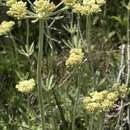en
names in breadcrumbs


Eriogonum heracleoides (common names; parsnipflower buckwheat, whorled buckwheat, and Wyeth buckwheat[1]) is a plant of western North America that has many flowering clusters which are usually cream colored, or off-white. It can usually be found in rocky areas, such as sagebrush deserts and Ponderosa pine forests. Parsnipflower buckwheat is in the genus Eriogonum and the family Polygonaceae, which is a family of plants known as the "knotweed family". It inhabits much of the western part of the United States and southern British Columbia.[2][3]
The parsnipflower buckwheat is an erect herbaceous perennial plant rarely more than 40 cm (15+3⁄4 in) tall. Blooming early in the summer, its flowers measure 4–9 mm (1⁄8–3⁄8 in); these are pale yellow and redden with age.[4] The leaves are arranged in loose rosettes, covered with soft hairs measuring 5–30 mm (1⁄4–1+1⁄8 in). The hairs feel woolly and matted, and cover both sides of the leaf.[5] The flowers have one carpel (achene). The plant has a whorled arrangement of leaves at midpoint of the stem[6][7] as well as one beneath the base of the stems.[4] It blooms in early to mid summer. It attracts butterflies, bees, insects, and birds and is the host plant for several Palouse butterflies.[8]
Eriogonum heracleoides (common names; parsnipflower buckwheat, whorled buckwheat, and Wyeth buckwheat) is a plant of western North America that has many flowering clusters which are usually cream colored, or off-white. It can usually be found in rocky areas, such as sagebrush deserts and Ponderosa pine forests. Parsnipflower buckwheat is in the genus Eriogonum and the family Polygonaceae, which is a family of plants known as the "knotweed family". It inhabits much of the western part of the United States and southern British Columbia.